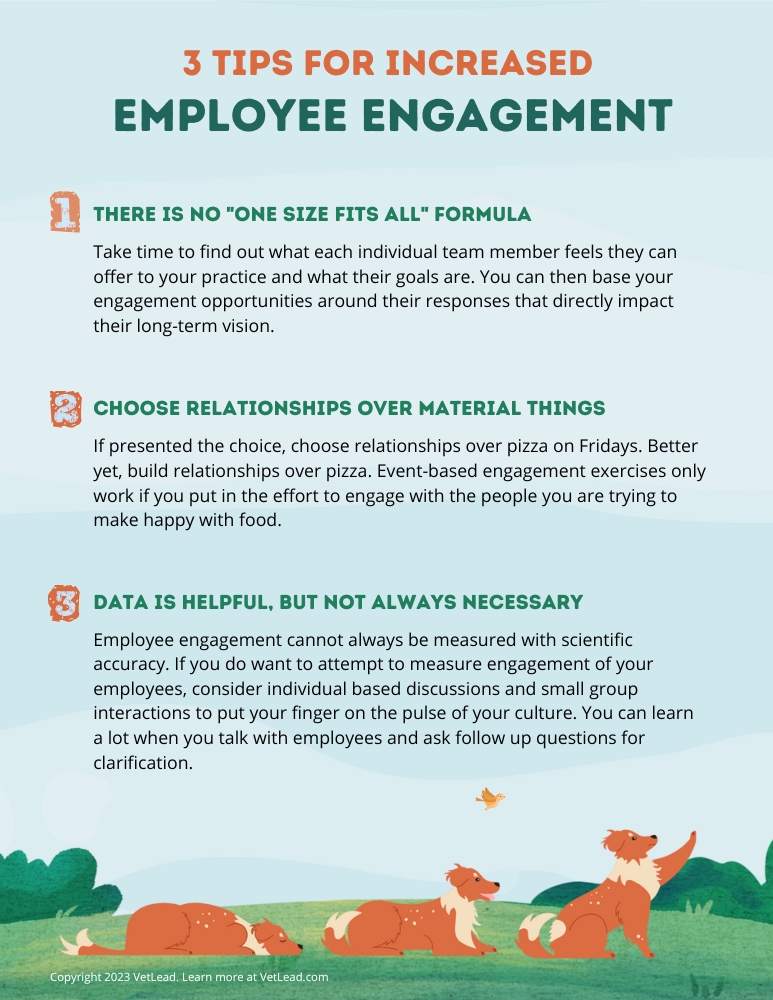Check our the recording of our latest live event, Navigating Difficult Conversations
Imagine a veterinary practice where employees feel fulfilled. They are ready to take on challenges, and want to contribute to its future success. A place that’s educational and engaging.
Several studies show that places with engaged employees are more profitable and productive. They change faster and have lower attrition rates. The studies also proved that highly capable and talented people want to work and stay at these types of workplaces and they attract better talent.
In the Towers Perrin study from 2004, 66% of highly engaged employees reported that they had no plans to leave their company, while only 3% of them were actively looking for a new job. For disengaged employees, the figures look a lot different. 12% weren’t going anywhere and 31% were looking for another way to earn their keep.
Defining Employee Engagement
But what is employee engagement? It’s best defined as employees who show up because of what they contribute to the practice, not what they get from it. These staff members are excited to start the day. They're happy to greet the clients on the appointment schedule. They perform morning treatments on the hospitalized patients and walk the boarders with purpose. They are willing and able to deliver beyond expectations.
The Veterinary Leadership Program
Get info on this exclusive program.
Learn how to:
- 1Build an accountable team
- 2Make change happen
- 3Improve performance
- 4Hire exceptional talent
Includes live coaching.
Investment will be $897 per person
Leaders make a huge difference in how we engage our employees. We are the ones who create engagement or disengagement. Bottom line: employee engagement matters a lot.
Here are a few tips about building and sustaining an engaging practice.
1
There is No "One Size Fits All" Formula
I have talked with several practice owners and managers about employee engagement and their views range greatly. There are those who believe the employee’s paycheck is the only thing needed to show up to work each day and perform.
On the other hand, some practices go to great lengths to use monetary incentives and free food to increase employee engagement. In my opinion, none of these efforts are right or wrong. It all depends on the employee and the sincerity of the efforts behind the engagement strategies. Additionally, what works for one employee to increase engagement may not work for the next.
Take time to find out what each individual team member feels they can offer to your practice and what their goals are. You can then base your engagement opportunities around their responses that directly impact their long-term vision.
2
Choose Relationships Over Material Things
If presented the choice, choose relationships over pizza on Fridays. Better yet, build relationships over pizza. Event-based engagement exercises only work if you put in the effort to engage with the people you are trying to make happy with food.
I have worked with practices where the owner brings in pizza or cake and they have someone at the front desk relay it to the back. Granted, everyone flocks to the lunchroom for a free lunch or snack. But at the end of the day, the only outcome this produces is satisfied appetites, not engaged employees.
If you want to use food to increase engagement, it is a great lure to get people to show up. You then have to be there to interact and ask them how their day is going. You may ask, “what skills did you have the opportunity to work on this week” or talk about something they did that they felt really impacted a practice goal.

Download this PDF Now
Share this with leaders in your practice. No email address required.
Better yet, come prepared with specific praise about something they accomplished recently. The same principles apply when using any sort of tangible item to increase engagement … even money! Don’t give a bonus to an employee without being able to explain why. You must tie it back to an action that really impacted the team or practice.
3
Data is Helpful, But not Always Necessary
Employee engagement cannot always be measured with scientific accuracy. That doesn’t mean it is any less real, important, or impactful. Often times it can be best measured by monitoring the other outputs of your practice. How has medical care and client service improved? Has your number of referrals increased? Is your turnover rate lower? How does income look?
If you do want to attempt to measure engagement of your employees, consider individual based discussions and small group interactions to put your finger on the pulse of your culture. You can learn a lot when you talk with employees and ask follow up questions for clarification. Your staff often holds the solutions and ideas needed to take your practice to the next level.
Conclusion
I hope these concepts help as you think through the engagement efforts within your practice. Keep in mind, engaged employees show up to the job each day for what they can add to the practice, not what they get paid to complete each day.
Leaders should foster a culture that makes people feel valued and connected, whether they are a veterinarian or in a kennel position. Employee engagement is one of the most effective ways to drive the mission of the your practice forward.
What do you think? Let us know in the comments section below.